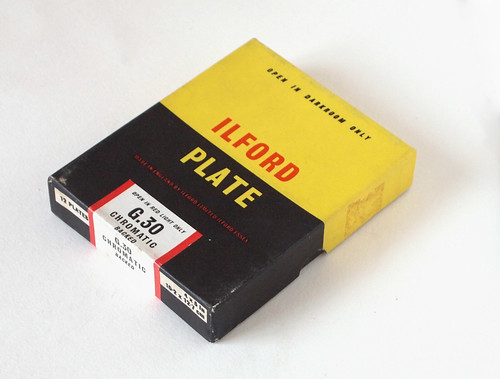 |
| Ilford G.30 Chromatic backed plates |
Following the first
vintage glass plates I shot last year, I've been keen to use more, although I have only found time to do so recently. I bought a couple of previously unopened boxes of
Ilford G.30 Chromatic glass plates in 4x5 size; one of the film holders for my
MPP large format camera takes glass plates (it does also have film sheaths, which can be inserted to shoot film). As the label states 'Open in red light only', the word 'Chromatic' appears to mean
orthochromatic; where the label continues onto the underside of the box it also states, "Meter settings for minimum exposure ASA 10 DIN 11". The design of the packaging suggests the plates are from the 1960s; the
leaflet inside the box has a code number L.64/D, which might refer to the year of printing, 1964.
For the first test I metered for 10 ISO, and took three successive exposures on the same plate, progressively withdrawing the darkslide between each shot (although not very evenly). Viewed from left to right, this effectively achieved exposures indexes of 10, 5, and 2.5. The plate was
stand-developed in R09 One Shot (Rodinal), at a dilution of 1:100 for one hour, with a couple of inversions at the half hour mark.
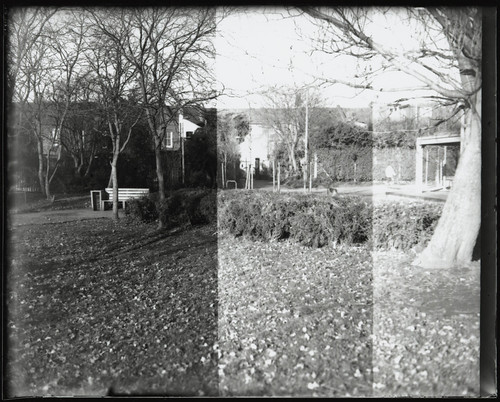 |
| Ilford G.30 Plate test - three successive exposures at 10 EI |
There is some blurring due to a small amount of
movement between the multiple exposures, but in terms of a test to determine a working exposure, it's clear enough. The first exposure at 10 EI appears to be workable, and initially I did think that this might have meant that the plates hadn't lost any sensitivity over the 50 years since manufacture, but Flickr member
richard314159 reminded me of the
doubling of film speed by the ASA in 1960. This change in standards simply reduced the margin of error against under-exposure. Although I can't be sure that the plates are from before the revised ASA settings, if so the plates would have originally been 20 rather than 10 by modern standards, and so may have lost one stop in sensitivity. There's also not much background fog on this plate, probably not much more than I've
got with some contemporary films; from my limited experience, slower emulsions do appear to age better.
I subsequently shot two plates at night with long exposures. On first inspection, these seemed like they might have been over-exposed, but, particularly with the second plate below, this was important to register the foreground detail, although at the expense of the clarity of the lit-up lettering. The haloes around the lights are somewhat unusual, this may be due to the fact it's shot on glass. It is also noticeable that there's a line of thicker emulsion at two of the adjacent edges where, as it was poured onto the plate, the emulsion collected as the excess was poured off.
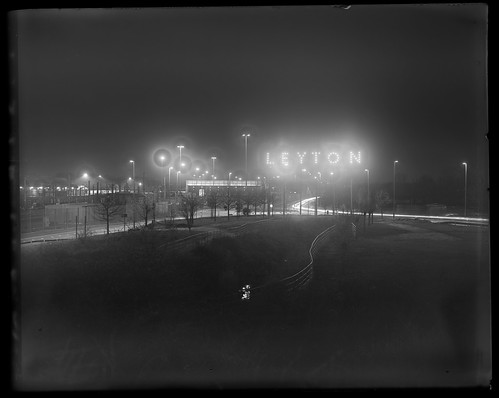 |
| Ilford G.30 Plate - 1 minute exposure at f5.6 |
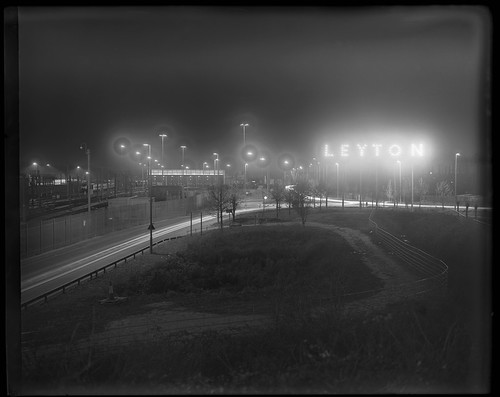 |
| Ilford G.30 Plate - 2mins exposure at f5.6 |
Edit: 29/04/13
As a result of my research into Ilford, I discovered the
Ilford Technical Information Book,
which contains a sheet on the G.30 Chromatic plates,
dated to 1965. This provides additional information for the plates from
the
leaflet in the box. It describes the G.30 Plate as
widely used for the photo-micrography of metal specimens. It is particularly useful for green-corrected microscope lenses since it allows comparatively short exposures to be given when using a Tricolour Green filter.
Ilford G.30 Chromatic Plates are used in the graphic arts, copying and scientific fields. For graphic arts work the main use is in the preparation of continuous tone negatives.
It gives the ASA setting for tungsten lighting
as 5, against the daylight setting of 10. The date of the technical information sheet disproves the idea above after my first test that the meter settings were from before the change in speed ratings for black & white emulsions, and so the plates have lost very little sensitivity since they were made nearly 50 years ago. The table of development
times gives further dilutions and times for both continuous and
intermittent agitation.
 |
| Ilford G.30 Chromatic Plate development times |
 |
| Ilford G.30 Chromatic Plate sensitometric curves |
I subsequently shot some more plates with my
MPP Micro-Technical camera, the best of which is below, a difficult subject given the brightness of the fluorescent strip lights under the awning compared to the building above.
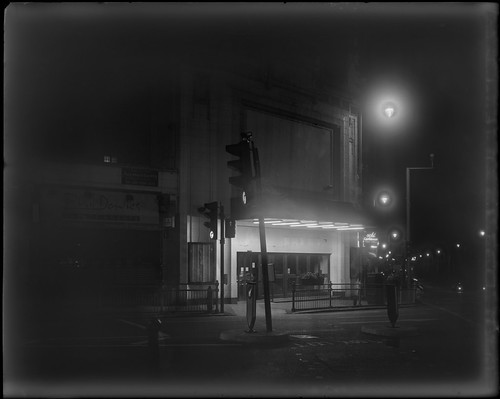 |
| Ilford G.30 Plate, 12 seconds exposure at f4.5 |







Thanks for this - very interested in the potential of glass plates. Pretty amazed they still work! I also found some Ilford G.30 plates, and shot them at 10iso - after your comments, but processed them in HC110B for ten minutes - seemed perfectly good at this.
ReplyDeleteThanks for your comment. I've only used Rodinal as a developer, so it's useful to know what else works. Have you posted your results anywhere?
ReplyDeleteYes, it is on www.photographync.blogspot.co.uk - the blog of the photography department at Northampton College, where I lecture in photography. Apparently, HC110 is good at reducing fog on film so I use it for out of date Kodak Infrared film. (It is of course ALL out of date, but I keep it frozen) I have used Rodinal extensively, but mostly for Agfa film. On the blog there are also several posts about an exhibition I mounted at the Bibliotheque in Bourges - it is about some discovered glass plates from which I printed images in the darkroom. These feature the Témoin family, and most were photographed on Lumiere 'Plaques Bleu' - a very fast plate from 1900, that allowed exposure times of around 50th sec.
ReplyDeleteWhen glass plates are described as 'backed', what does this mean? Is it something that has to be rinsed off after processing? Any ideas?
ReplyDeleteIt's anti-halation backing, which dissolves during development, although I usually pre-soak before developing and I assume it comes off then, it sometimes imparts a colour when first emptying the tank- there's no separate step needed to get rid of it.
DeleteThanks for posting the link above too.